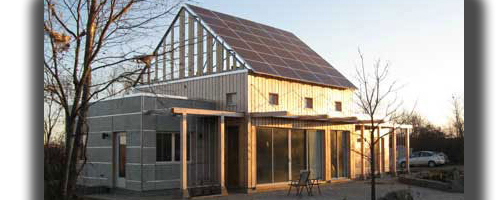
The Future of Roofing
Average Rating
Rate This Article
Most Popular Roofing Cities
Related Articles
Roofing Contractor Roofing Costs: An In-Depth Breakdown Building Your Own Rooftop Garden Copper Roofing Corrugated Roofing Fiberglass Roofing Flat Roofing Metal Roofing Rubber Roofing Steel Roofing 5 Ways to Fix a Leaky Ceiling Green Gutters A History of Rooftop Gardens How to Winterize Your Roof A Review of the iRobot Looj Gutter Cleaning Robot Solar Shingles get State of the Union Plug Atlanta Roofing Contractors and Projects Chicago Roofing Contractors and Projects Chicago Roofing CostsLike most commercial enterprises, the construction industry never stands still. Innovations are constantly being made. Case in point, we may soon see the demise of the asphalt shingle, as the future of roofing begins to come into focus.
While low-cost, asphalt shingles also have a short lifespan and when thrown out are shipped off to landfills. With the green trend in full gear, roofing innovators are focusing on saving energy, saving money, and saving the planet. Here’s a small peek into the potential future of roofing.
Solar-paneled shingles
Solar-paneled shingles, or photovoltaic shingles, are one of the most promising new developments in the roofing field. In addition to protecting your house from environmental effects, solar paneled shingles last longer than asphalt shingles. While they are more expensive than asphalt shingles, they don’t need to be discarded as often, and they also provide your home with valuable electrical power, thus lowering your energy bills. Solar panel shingles are approximately the size of normal asphalt shingles, but they contain cells designed to capture energy from the sun and convert it to a DC current for use inside your home. These wireless shingles snap together and are designed to work with ordinary asphalt shingles, which means the installation process is similar to that of regular shingles—with a hammer and nails.
A variation on the solar paneled shingle is the solar-paneled tile, which looks like a traditional rounded clay tile but features photovoltaic technology.
Thermeleon Color-Shifting Roof Tiles
The Thermeleon roof tile is a tile that, like its namesake the chameleon, can change colors depending on environmental conditions. Developed by a team of MIT students, the Thermeleon tile will become black in chilly weather and white in hot weather. The tile uses a combination of polymers and solvents, which are trapped in a plastic casing with a black backing. At a cold temperature, the white polymer remains invisibly dissolved in the solvent. As it heats up, the polymer solidifies, making the tile appear white. Essentially, a house with a Thermeleon roof would appear to have a white roof in the summer, and a black roof in the winter. While this may turn off some wishing their home’s aesthetic to remain constant, the energy-saving benefits are apparent.
The Living Roof
This idea for the future of roofing actually comes from the past, when prehistoric and Middle Age Scandinavians would construct houses with turf roofs. The living roof is the ultimate green roof. It is composed of dirt, rocks, and plant life which are integrated into the roof structure. The rooftop fauna helps regulate the building’s temperature and actually reduces the water use inside the building. This type of roofing appears to be more practical for commercial buildings which are much larger than residential homes. If the living roof gains popularity, it’s possible that we may begin to see small farms or wildlife habitats or appearing on urban rooftops. Animals that have lost their homes due to commercial development, like insects or birds, may one day return to the city.
Metal Trusses and Shingles
Another roofing option that is already beginning to take hold is metal. The advantages of metal over asphalt are many. A metal shingle is more durable than an asphalt shingle, with the added environmental benefit of being completely recyclable at the end of its life. Reflective metal roofing repels sunlight instead of absorbing it like regular asphalt, which keeps the home cooler in the summer and helping you save on air-conditioning expenses.
Trusses made of galvanized steel are beginning to replace those made of wood. Unlike wood, galvanized steel is not vulnerable to warping. Neither is it vulnerable to infestation, moisture, and dry rot.
If you’re interested in a new roof for your home, you can browse roofing contractors in your area simply by clicking the appropriate link on the top of this page.
Stay tuned to Signature Contractors for more construction news and information.
--Gary K. Johnson





